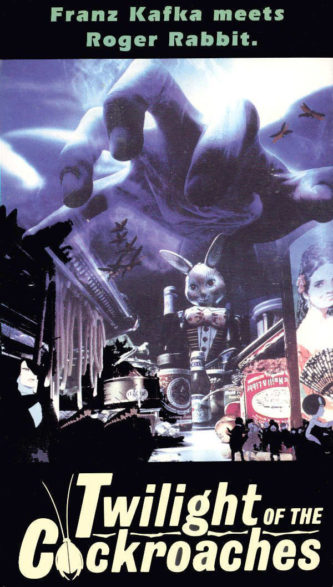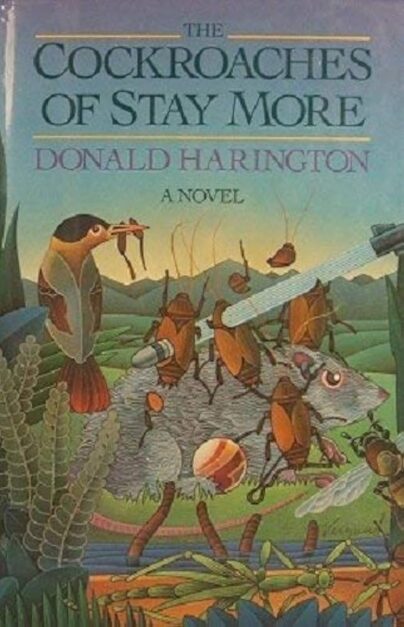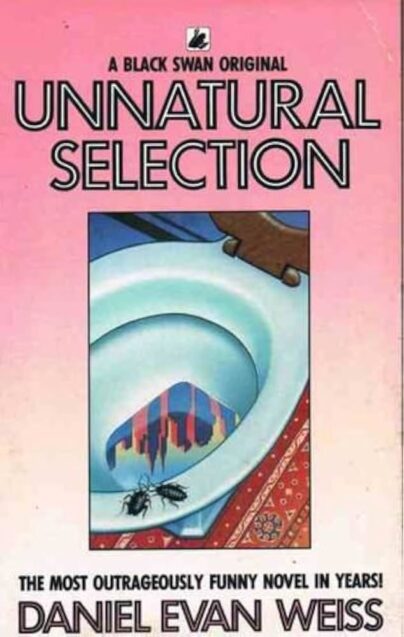The phenomenon of like-minded books and/or movies appearing around the same time is hardly novel. Consider the situation in the mid-1930s, when several end-of-civilization novels appeared, or the early 1970s, when ALICE IN WONDERLAND inspspired surreal fantasy films were suddenly all the rage in Europe, or the years 1986-87, when a handful of gritty Nam movies cannibalized one another’s box office prospects.
Here I’m going to explore possibly the most bizarre such instance, which occurred over roughly a one-year period in 1989-90. It was then that not one but three accounts appeared—specifically one film, TWILIGHT OF THE COCKROACHES, and two novels, THE COCKROACHES OF STAY MORE by Donald Harrington and UNNATURAL SELECTION by Daniel Evan Weiss—with roughly identical stories of intelligent cockroaches whose existence is threatened by the romantic wiles of the roaches’ human overseer.
 Since all three accounts appeared around the same time, the issue of plagiarism is a moot one (in truth TWILIGHT OF THE COCKROACHES appeared in 1987, but didn’t make it to the English speaking world until 1990). Certainly the cockroach presents all manner of philosophical and metaphoric possibilities, as Franz Kafka demonstrated fifty years prior to this trio’s combined appearance (never mind that the critter in Kafka’s METAMORPHOSIS was in a fact a beetle rather than a cockroach). Precisely what significance cockroaches might have had in the late 1980s-early 90s I’m not sure, yet it was then that this film and two novels debuted. They’ve even proven somewhat influential in the years since—see THE LIFE OF INSECTS by Victor Pelevin and INSECT DREAMS by Marc Estrin, both of which recall the cockroach trio under discussion, and the 1996 film JOE’S APARTMENT, which was admittedly influenced by TWILIGHT OF THE COCKROACHES.
Since all three accounts appeared around the same time, the issue of plagiarism is a moot one (in truth TWILIGHT OF THE COCKROACHES appeared in 1987, but didn’t make it to the English speaking world until 1990). Certainly the cockroach presents all manner of philosophical and metaphoric possibilities, as Franz Kafka demonstrated fifty years prior to this trio’s combined appearance (never mind that the critter in Kafka’s METAMORPHOSIS was in a fact a beetle rather than a cockroach). Precisely what significance cockroaches might have had in the late 1980s-early 90s I’m not sure, yet it was then that this film and two novels debuted. They’ve even proven somewhat influential in the years since—see THE LIFE OF INSECTS by Victor Pelevin and INSECT DREAMS by Marc Estrin, both of which recall the cockroach trio under discussion, and the 1996 film JOE’S APARTMENT, which was admittedly influenced by TWILIGHT OF THE COCKROACHES.
If ever a movie deserved points for originality and audacity it’s TWILIGHT OF THE COCKROACHES, or GOKIBURI-TACHI NO TASOGARE, an audacious mixture of live action and anime. It centers on Naomi, a teenage cockroach living in the apartment of Seito, a slob who creates a veritable paradise for the local roach population. Things change, however, when Seito falls in love with a neat-freak woman who demands he clean up his apartment. These two lovebirds arm themselves with cans of bug spray and go to work, nearly wiping out the entire roach colony. In the end only Naomi is left alive, and does her part to carry on the colony by birthing a new litter of roaches.
The combination of live action and anime is poorly executed, with the two-dimensionality of the animation thrown into extremely stark relief by the live action. Yet director Hiroaki Yoshida nearly overcomes that problem through his conceptual brilliance and fertile imagination. The human-faced roaches are wonderful creations, and the presentation of their universe—in which common household objects are rendered gigantic and a backyard creek becomes a raging river—is nothing short of brilliant. Ditto the visual design of Seito’s apartment, which with its mounds of rotting food and spilled wine is presented as a sort of mini-Las Vegas for the roaches, and his bathtub as a beach resort.
Yoshida claims the film’s cockroach colony was intended as a metaphor for modern Japan (with Seito the slovenly apartment owner representing, presumably, the USA), and he makes pertinent points about genocide, media manipulation and modern warfare. While it initially seems like a comedy, you may find yourself surprised at how sad and impacting TWILIGHT OF THE COCKROACHES ultimately turns out to be.
 On to THE COCKROACHES OF STAY MORE by Donald Harrington, published in 1989. It’s a breezy southern novel with everything that term implies. It is once again headlined by cockroaches, who somehow all possess human-level intelligence and talk to each other in quintessentially southern drawl. They reside in the Arkansas home of a romantic sad sack named Larry, who these “Crustian” roaches worship as a god. Larry is pining away for his lost love Sharon, who lives nearby, in a house occupied by the novel’s cockroach hero Sam, a.k.a. Gregor Samsa Ingledew.
On to THE COCKROACHES OF STAY MORE by Donald Harrington, published in 1989. It’s a breezy southern novel with everything that term implies. It is once again headlined by cockroaches, who somehow all possess human-level intelligence and talk to each other in quintessentially southern drawl. They reside in the Arkansas home of a romantic sad sack named Larry, who these “Crustian” roaches worship as a god. Larry is pining away for his lost love Sharon, who lives nearby, in a house occupied by the novel’s cockroach hero Sam, a.k.a. Gregor Samsa Ingledew.
The philosophically inclined Sam doesn’t go along with the beliefs of his Crustian fellows, preferring to hang out by himself in Sharon’s grandfather clock—even though the constant clanging of its gongs has made Sam deaf. For that matter, Sam’s fellow roaches are starting to tire of their lord and master, whose slovenly behavior is far from godly. When Larry shoots himself in the foot during a drunken stupor the cockroaches consider moving their base camp from Larry’s “Holy House” to Sharon’s more immaculate residence. Along the way the roaches befriend a rat, attempt to communicate with Sharon by forming a large arrow on the ground with their bodies, and use a typewriter to compose a poem about human-cockroach relations.
It all adds up to a witty and enjoyable account with much to say about human behavior and our responsibility to the animal—or in this case insect—kingdom. The novel may, however, be a bit overlong at 337 pages. Kafka, let’s not forget, brought in his cockroach story at less than a third of that length, and covered just as many metaphoric and philosophical bases.
Finally we have UNNATURAL SELECTION by Daniel Evan Weiss. This bizarre novel didn’t turn up in the US until 1994 (under the title THE ROACHES HAVE NO KING), with its initial UK-only publication occurring in 1990.
until 1994 (under the title THE ROACHES HAVE NO KING), with its initial UK-only publication occurring in 1990.
If TWILIGHT OF THE COCKROACHES was an Eastern-centric downer and THE COCKROACHES OF STAY MORE a Southern-fried goof, UNNATURAL SELECTION represents the freaky NYC hipster take on this particular material. It’s told from the POV of Numbers, a smart and resourceful cockroach residing in the big city apartment of Ira, a dweeb whose girlfriend, the shrewish Ruth, is moving in with him. Unfortunately for Numbers and his roach fellows, Ruth is something of a neat freak, which, as the critters of TWILIGHT OF THE COCKROACHES learned, is a terrible thing for cockroaches.
Being abnormally intelligent after eating their way through various books, whose knowledge the roaches have apparently absorbed, Numbers and his fellows decide to use their insectoid wiles to remove Ruth from the picture and encourage a romance with Elizabeth, a hottie living next door. Along the way Numbers gets a tour of the apartment’s sewer system after being flushed down a toilet, is briefly stuck in a roach motel, and has a change of heart about Ruth after an eroticized encounter with her vagina.
The latter depiction may explain why UNNATURAL SELECTION had such a hard time finding publication in the US. Weiss isn’t exactly subtle in his depictions of interspecies sexuality, nor in passages like the one in which Numbers looks up from the bottom of a toilet at the assholes of his human hosts defecating. Yet outside the grotesquerie the novel is funny and disarmingly intelligent in its depiction of human (mis)behavior viewed from a non-human perspective, and drafted in sufficiently erudite yet lively and kinetic prose.
Of course, the concept of cockroaches who can reason with the same facilities as humans is a bit farfetched, to say the least. This is obviously an issue that afflicts all three accounts. As in TWILIGHT OF THE COCKROACHES and THE COCKROACHES OF STAY MORE, UNNATURAL SELECTION doesn’t resort to a science fictional gimmick (such as the ever-popular device of radiation contamination) to explain the roaches’ abnormal intelligence, which, also in common with the two other accounts, is both a virtue and a hindrance. This is to say that the less gimmicks an author/filmmaker employs the better, but that doesn’t make the reader’s suspension of disbelief any easier.
